|
SALERNO
Salerno was
one of the bloodier, more critical operations of the Second
World War. For a time the action hung in the balance as strong
enemy counterattacks smashed and threatened the very existence
of the initial beachhead. But at the last a gallant defense held
firm and Salerno was won. This was the opening struggle of the
long and bitter Italian campaign.
On their first combat
mission, 36th Division troops under the command of Maj. Gen.
Fred L. Walker became the first American division to invade the
European mainland and test Hitler's continental fortress. Before
dawn of Thursday morning, September 9, 1943, without previous
naval or air bombardment, the leading waves stepped ashore on
the sandy beaches near ancient Paestum.
The Italian surrender had
been announced only the night before. Unwarranted optimism was
soon reduced as the Germans in waiting faced the invaders.
Shoved back from the beaches, the enemy thrust powerfully at
Altavilla and along the Sele River. Casualties were heavy.
Airborne reinforcments arrived from Sicily at the height of the
battle.
PAESTUM
BEACHES ARE STORMED WHILE GERMAN ARTILLERY RAINS
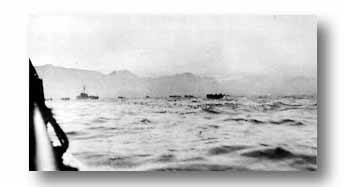
SMALL LANDING
CRAFT (LCVP'S) MOVE INLAND PREPARATORY TO INVASION
ON
GRAY MORNING OF SEPTEMBER 9. |
From the high
range of hills surrounding the Salerno plain, German
artillery was emplaced to protect the invasion
shoreline. The enemy had been forewarned of the
approaching fleet and had issued an alert to its beach
defenders at 1600 of September 8. |
|
| Soon after the
first two assaultwaves had slipped silently ashore
under the cover of morning darkness, enemy gunners
were aroused. At the medieval Paestum tower German
machine gunners and snipers fired from the
balcony. |
|
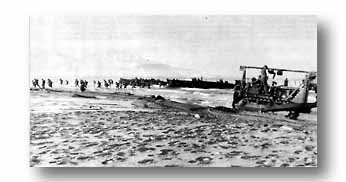
INFANTRYMEN POUR
ONTO THE BEACHES AS BULLDOZER, LATER HIT BY ENEMY
SHELL, WORKS TO CLEAR BEACH
OBSTACLES. |
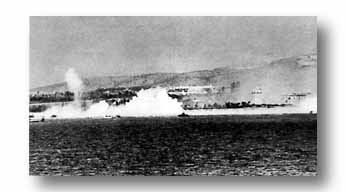
GERMAN ARTILLERY
THROWS GEYSER WHILE ALLIED SMOKE SHIELDS LANDING.
tOWER WAS ENEMY STRONGPOINT. |
|
At daylight
German artillery began to pound the beaches. To
counter, Navy craft laid smoke screens while landing
boats laden with troops, guns and supplies edged in.
As infantrymen slugged forward toward their
objectives, bulldozers and engineers feverishly worked
to clear the beach obstacles, teller mines, and barbed
wire. Engineers also prepared roads and outlets in
order to receive the massing stores of supply.
|
| Enemy planes in
ever greater numbers skipped in to harass the landing
operations. |
|
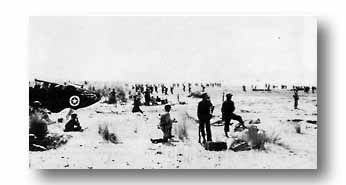
IN MID-D MORNING
ITALIAN SUNSHINE IS CRISP, NAVAL BEACH OFFICERS
SPEED
UNLOADING AND TROOP MOVEMENT. |
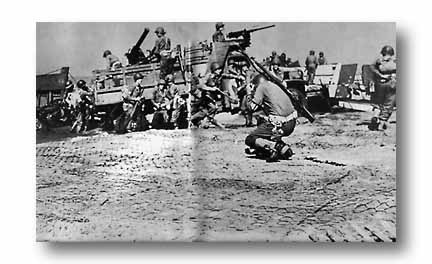
Flushed with the
excitement of making the long-awaited invasion of
the
Italan mainland, Texas Division troops disembark
on-the-double. Enemy artillery fire has been heavy
and
machine guns on the trucks are trained skyward. The
MP
in foreground ducks instinctively as a shell hits
nearby. |
SALERNO
STORY
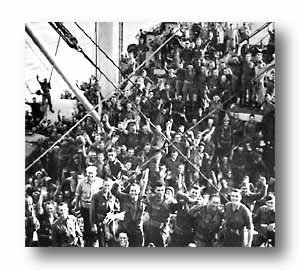
WE THOUGHT IT WOULD BE EASY.
General Eisenhower's dramatic announcement of
Italy's
unconconditional surrender came over the ship's
radio
at 1830 on the eve of the invasion and started
speculation as to whether there would be any
fighting
at all on the following day. Commanders assured the
troops that there would be, but smiles and moderate
celebrations could not be
restrained. |
|
The first wave
fanned out onto all four beaches exactly at H-Hour,
0330. Enemy guns roared as 36th Division infantrymen
leaped into the water and started inland for the
pre-designated assembly areas. On the left at Red and
Green beaches the 142nd Infantry, commanded by Colonel
John D. Forsythe, began the push that was designed to
take it to the core of the beachhead and to the ground
around Albanella and Altavilla. On the right at Yellow
and Blue beaches, the 141st Infantry under Colonel
Richard J. Werner, moved to maintain contact with
142nd at Mount Vesole and Magliano, seize Agropoli and
defend the right flank. The second and third waves hit
the beaches at eight-minute intervals.
|
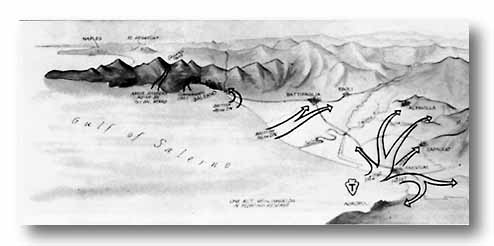
Both assault battalions
of the 142nd on Red and Green beaches were pinned down from time
to time. On the right flank the assault battalions of the 141st
Infantry landed on schedule and began working through wire
obstacles and mines. Intense fire from machine guns, field
pieces, mortars, and tanks made their progress
difficult.
| Everywhere there
was great confusion. Officers and men were separated;
assembly points were not easily located. Shortly after
0530, the amphibious "ducks" came ashore.
The 133rd Field Artillery Battalion brought in twelve
105-mm howitzers. Each of these guns was loaded on a
"duck," together with 21 rounds of
ammunition and a gun section of seven
men. |
|
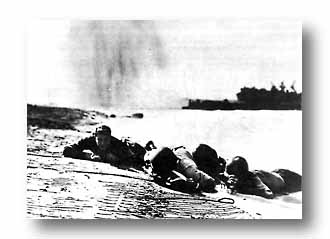
NAVAL BEACH PARTY ASSUMES THE
HORIZONTAL WHEN ENEMY PLANE SKIPS IN. NOTE BOMB
SPRAY. |
At 0640 the 143rd
Infantry, initially in reserve and commanded by Colonel William
H. Martin, crossed the beaches and began moving toward Cappacio,
a village on the slopes of Mt. Soprano.
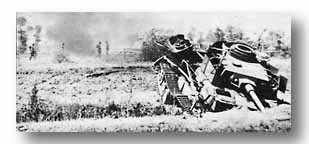
MUTILATED GERMAN MARK IV TANK
which had counter attacked on the beaches in an
attempt to drive the 36th back into the
sea. |
|
Almost from the
moment of landing, enemy tanks in scattered positions
had made it difficult for all combat teams to reach
their objectives, but not until 0700 did they attack
on a large scale. At this time the battalions of the
141st were still attempting to reorganize when they
were struck by 15 or more Mark IV's, five on each
flank and at least four in the center.
|
Then a column of the 36th
Cavalry Reconnaissance Troop landed on Yellow Beach and helped
to fight off seven Mark IV's which were firing opposite the
right flank. In the center of the 141st line, the men of the 2nd
Battalion beat off tanks with infantry weapons. Meanwhile, more
tanks threatened the 1st Battalion in the fields south of Blue
Beach. For its role in repulsing the enemy tank attacks, Lt.
Col. Edward D. McCall's 3rd Battalion of the 141st was awarded
the Division's first Presidential Unit Citation.
By noon the main tank
assualt on the southern beaches had been brought virtually to a
stanstill. Naval gunfire and fire from mortars and howitzers had
helped to make the operations costly for the enemy, but to a
large extent the battle had been fought by infantrymen and
infantry weapons.
To the north the
principal tank attacks came later. At 1145 Division CP personnel
in the tobacco warehouse at Casa Vannulo saw 13 German tanks
approaching. From the ditches along the railroad the men watched
the enemy come within easy range. On the main coastal highway an
artillery piece, set hastily in defense, opened fire. Another
howitzer was brought up and unlimbered from its "duck"
carrier even as the tanks were nearing, and fought off the
German armor. When five of the enemy tanks were KO'd, some at
200 yard range, the rest of the Germans turned.
| Throughout
D-Day, while the 142nd on the left flank fought toward
Hill 140, and the 141st on the right struggled
forward, the 143rd RCT was forced to occupy a wide
front in the center as it avanced. On the left flank
of the Division, Lt. Col. Samuel S. Graham had
assembled elements of the 2nd Battalion, 142nd near
Paestum station at 0645 and with them moved east to
the Capodifiume River, a half hour
later. |
|
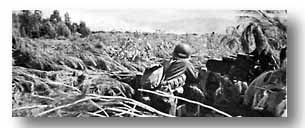
AN INFANTRY OFFICER takes cover
in an abandoned enemy emplacement as German mortar
fire sweeps the beaches during an early stage of the
invasion. Prepared positions and mines were numerous
on Salerno beaches. |
By 1000, Colonel Martin
assembled the 143rd's two leading battalions, the 2nd and 3rd,
at the railroad. Their objective was Hill 386, a projection
running northwest from Mount Soprano and ending abruptly in a
cliff just above the junction of the roads to Capaccio and Rocca
d"Aspide. Mount Soprano, dominating the entire area, was an
important objective of the Division. By nightfall on D-Day the
143rd controlled the southeast slope of Mount Soprano and a
vital stretch of the road leading to the plain.
In anticipation of the
fierce struggle, Lt. Col. John N. Green, commanding the 132nd
Field Artillery Battalion (Pete Green's Mortars) coined a
Division classic on the eve of D-Day.
Asked by one of his men,
"What are we going to do if we run out of
ammunition?"
"Fight with the
Rammerstaff!" was the Colonel's bellowing reply.
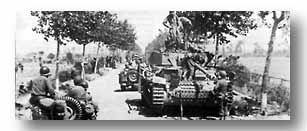
ON THE SECOND DAY of the
battle, units of the 45th Division pass an enemy
tank
which was knocked out near the 36th Division CP in
the
tobacco warehouse. Four other German tanks lay
shattered in fields nearby. |
|
The 36th
Division, untried in battle, had landed under fire,
overcome prepared beach defenses, and reached its
initial objective. The Allies now controlled the plain
south of the Sele River and occupied the high ground,
an average distance of five miles from the beaches. On
the right flank, the 141st Infantry had absorbed
vicious enemy attacks, but was ready to occupy its
assigned objectives on September 10. Men, vehicles,
artillery, and supplies continued to pour onto the
beaches, where the engineers labored efficiently under
constant fire. The hours of confusion had
passed. |
Dumps were set up, exit
roads were operating, anti-aircraft batteries were in position,
and communications finally working.
The Salerno landing had
been sucessful in spite of a prepared and alerted enemy.
|